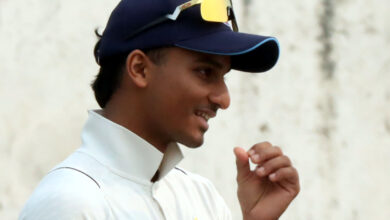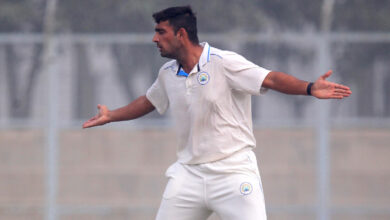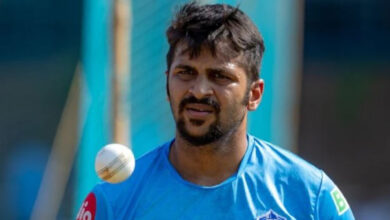Ishant Sharma still has plenty to offer

It’s the era of athletes ageing gracefully. Of them delaying the inevitable vagaries of time; of them not stopping the clock, but running alongside it; of them accepting their age and finding ways of resing that good night in their sporting middle age.
Last month, Rafael Nadal, with a ravaged 35-year-old body, outlasted a 25-year-old in a gruelling five-setter for his record 21st Grand Slam title. His great peer Roger Federer, at 40, could still be fuelled the dream of chasing Nadal. Elsewhere, 37-year-old Criano Ronaldo is pummelling goals with the relish of a 17-year-old in the toughest football league in the world, just like Jimmy Anderson, who turns 40 this year, was harassing batsmen for fun last summer.
So 33-year-old India pacer Ishant Sharma, snubbed for the two-Test series against Sri Lanka, needn’t feel old. Or that he wouldn’t be considered for Tests ever after, as is the popular perception. His omission is perceived in some quarters as the equivalent of handing him out the retirement papers. Far from it. Ishant could still be a relevant, and more importantly, a vital force in Indian cricket. He just had a couple of difficult games, there were young fast bowlers waiting to be groomed, and so he was dropped. A pragmatic performance-based, future-oriented decision.
It should not be misconstrued that Indian cricket no longer needs his services. For all the depth of newfound fast-bowling riches and resources, India’s is not a vastly-experienced bowling unit. Mohammed Shami had notched up 57 caps; Umesh Yadav 52 and Jasprit Bumrah 27. Of them, Shami and Yadav would turn 32 and 35 this year. Mohammed Siraj and Shardul Thakur, however impressive they had been, are in the nascence of their career. The young crew of Avesh Khan and Prasidh Krishna have not experienced much first-class cricket either. An injury or two, a bad run of form, or the necessity to rotate them, or a big series, and India could trust Ishant with the new ball.
Even if most of them were fit and available, his experience and knowledge could be invaluable. He is a leader, whose presence was at times missed in South Africa. And of all the bowlers in the squad, he seems the most natural person to groom the young brigade, for none of them have seen as much cricketing life as Ishant has, countered as much censure or ridicule, bad days or exit calls, as Ishant has.
Few have also transformed as dramatically as Ishant in recent times, perhaps in world cricket. From a merchant of the big-booming in-swinger, he went on to add subtle layers in his game to become one of the fiercest bowlers around, a clever manipulator of length, angles and lines, resulting in a late-career bloom. From 2016 to 2021, in 33 Tests, he averaged just 25.3, as against 41 before that. He is an anthology of career lessons for the new generation.
True that he had been lacklustre in recent outings. He was India’s most potent bowler in the first innings of the World Test Championship final and penetrative in the Lord’s Test against England. He bowled in just three more innings after that, and went wicketless in 44 overs. Even there he didn’t look like a spent force. He clocked effective pace, regularly moved the ball and occasionally produced a gem or two.
Rather, Ishant seemed just tired and afflicted in his last two games. There were no signs of terminal decline, and it seemed just a matter of sorting out injuries, taming the rebelling body parts, regaining rhythm and lifting his morale. He has been unfortunate with injuries — just before the tour to New Zealand in 2020, be twed his ankle and fractured it when appealing in the follow-through; the hamstring injury he sustained in the Indian Premier League the same year jeopardised the tour to Australia; then he injured his right arm while fielding in the WTC final, before he dislocated a finger on the right hand in Kanpur. Fast bowlers take time to reclaim their best after injuries, and Ishant could be wading through such a fleeting phase.
Road ahead
In the meantime, he could take a break, some time off the game, regain full fitness, rehab at the National Cricket Academy, perhaps fly out for a county stint and return refreshed for the last phase of his career. It’s rather more advisable than straightaway slogging in the Ranji Trophy in a desperate comeback bid. It would be a travesty of justice if Ishant’s potential is stalled forever. There’s more he could offer Indian cricket, just as Indian cricket could do its bit to preserve him with sharp workload management. Not being picked for the IPL is a blessing, he could channel all his energy into Test cricket.
Much, though, would depend on Ishant’s own determination, the state of his body, his awareness of the state of his body, how he would preserve it and how the team management regulates his workload. Fitness has seldom been a concern for him —his longevity bears testimony (among fast bowlers, only Kapil Dev has played more Tests than him). Fitness is an underappreciated aspect of his career — there have been few long injury-enforced lay-offs or an injury that seemed to threaten his career. He has not gone through lengthy rehabs or action tweaks to ward off injuries.
For motivation, Ishant could look towards Anderson and Stuart Broad. Anderson seemed a force on the wane in 2015, before masterfully adding more tools to his kitty; like the more profuse use of the leg-cutter, wobble-seamer, reverse movement from a good length (as when he scythed through India at Chepauk last year), better use of the old ball, and an absolute mastery on batsmen’s mind. After his 33rd birthday, the England legend gulped 227 wickets at an average of 21, as opposed to his pre-33 average of 29.
Not just Anderson, Curtly Ambrose played till 37, Courtney Walsh till he was 39, and both were every bit as sharp as they were in their late-20s, the supposed fast bowlers’ peak. After his 33rd birthday, Glenn McGrath continued to be the metronomic force as he had been and added 141 more wickets at 22 to his haul. So, it’s utterly conceivable that Ishant not just makes a comeback but goes on to enjoy a productive late-career surge in the milieu of gracefully ageing athletes.







